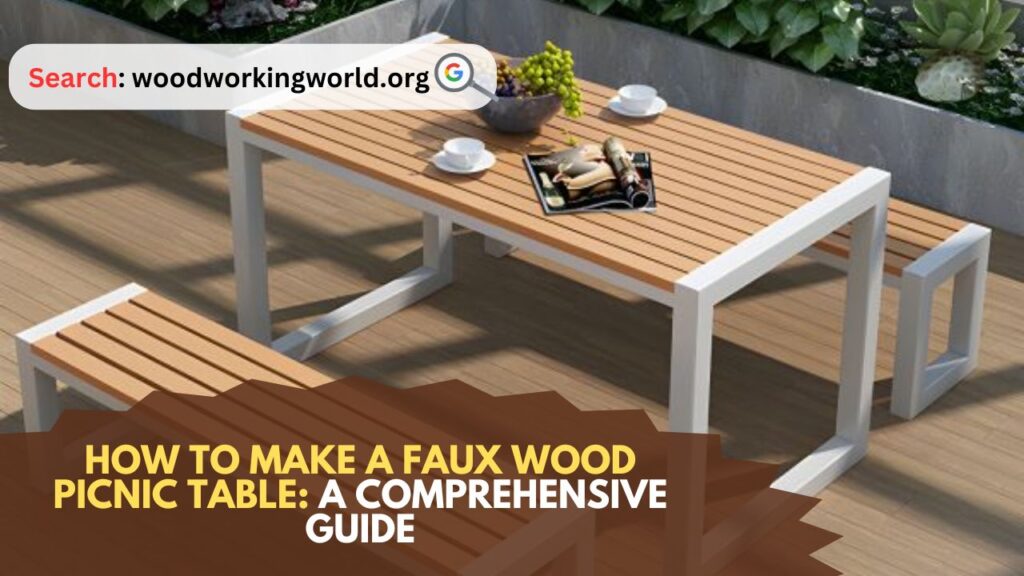Faux Wood Picnic Table: A picnic table is a timeless piece of outdoor furniture that brings people together for meals, games, and conversations. While traditional wood picnic tables have their charm, they require regular maintenance to withstand the elements. Enter the faux wood picnic table: a low-maintenance, durable alternative that mimics the look of real wood. In this guide, we’ll walk you through the steps to create your own faux wood picnic table, combining the aesthetic appeal of wood with the durability of modern materials.

How to Make a Faux Wood Picnic Table
Materials and Tools You Will Need to Make a Faux Wood Picnic Table
Materials:
- Composite Decking Boards: Choose a high-quality composite decking material that mimics the appearance of real wood. These boards will form the tabletop and seats.
- Pressure-Treated Lumber: Use for the table frame and legs. Pressure-treated lumber resists rot and insect damage.
- Galvanized Screws and Bolts: Ensure durability and resistance to rust.
- Wood Glue: For extra stability.
- Stain and Sealant: To enhance the faux wood finish and protect the table.
- Sandpaper: For smoothing edges and surfaces.
Tools:
- Measuring Tape: Accurate measurements are crucial.
- Circular Saw or Miter Saw: For cutting the lumber and composite boards to size.
- Drill and Drill Bits: For making pilot holes and driving screws.
- Screwdriver: For assembling the table.
- Clamps: To hold pieces in place while assembling.
- Paint Brushes or Rollers: For applying stain and sealant.
- Safety Gear: Gloves, safety glasses, and ear protection.
Step-by-Step Instructions
Step 1: Planning and Measurements
Before you start cutting any materials, it’s essential to plan your picnic table’s design and dimensions. A standard picnic table typically measures around 6 to 8 feet in length, 28 to 30 inches in width, and 28 to 30 inches in height. The bench seats are usually about 17 to 19 inches high. Adjust the measurements to fit your space and needs.
Step 2: Cutting the Frame Pieces
Using your circular saw or miter saw, cut the pressure-treated lumber to create the table frame. You will need:
- 4 Table Legs: Cut to the desired height (usually around 28-30 inches).
- 4 Long Frame Pieces: These will form the length of the table and the benches.
- 8 Short Frame Pieces: These will connect the long frame pieces and form the width of the table and benches.
Step 3: Assembling the Table Frame
Lay out the frame pieces on a flat surface. Begin by assembling the table frame:
- Attach the Legs: Secure the four legs to the long frame pieces using galvanized screws. Make sure the legs are evenly spaced and level.
- Connect the Short Frame Pieces: Attach the short frame pieces to form the width of the table and benches. Use wood glue and clamps for extra stability before securing with screws.
Step 4: Preparing the Composite Decking Boards
Composite decking boards often come in standard lengths. Measure and cut the boards to fit the dimensions of your table and benches:
- Tabletop: Cut enough boards to cover the width and length of the table frame.
- Benches: Cut boards to cover the width and length of the bench frames.
Step 5: Attaching the Composite Boards
- Lay Out the Boards: Place the cut composite decking boards on top of the table and bench frames. Ensure they are evenly spaced and aligned.
- Secure the Boards: Using galvanized screws, attach the composite boards to the frames. Drill pilot holes to prevent splitting and ensure a clean finish. Drive the screws through the boards into the frame below.
Step 6: Finishing Touches
- Sanding: Use sandpaper to smooth any rough edges or surfaces. This will help create a more finished look and prevent splinters.
- Staining: Although composite decking is already weather-resistant, applying a stain can enhance the faux wood appearance. Choose a stain that complements the color of your composite boards and apply it evenly using a brush or roller.
- Sealant: Once the stain is dry, apply a sealant to protect the surface from UV rays and moisture. This step will extend the life of your picnic table and maintain its appearance.
Step 7: Assembly and Placement
- Assemble the Table and Benches: Once all the pieces are finished, assemble the table and benches. Ensure all screws and bolts are tightened securely.
- Leveling: Place the table in your desired outdoor location. Use a level to make sure the table and benches are stable and even. Adjust as necessary by adding or removing soil beneath the legs.
Step 8: Enjoy Your New Faux Wood Picnic Table
Your faux wood picnic table is now complete! Gather your family and friends for a meal, enjoy outdoor activities, or simply relax and admire your handiwork. The low-maintenance, durable materials will keep your table looking great for years to come.
Tips and Tricks
- Safety First: Always wear safety gear, including gloves, safety glasses, and ear protection when working with power tools and cutting materials.
- Measure Twice, Cut Once: Accurate measurements are crucial for a well-built table. Double-check your measurements before cutting any materials.
- Pilot Holes: Drilling pilot holes before driving screws will prevent the wood from splitting and ensure a more secure fit.
- Weather Considerations: When placing your table outdoors, consider the local climate. In areas with extreme weather conditions, you might want to store the table under a cover or in a shed during the off-season to extend its lifespan.
- Personal Touch: Customize your picnic table by choosing different colors of composite decking or adding decorative elements such as a built-in umbrella hole or cup holders.
Maintenance and Care
One of the significant advantages of a faux wood picnic table is its low maintenance. However, to keep it looking its best, follow these simple care tips:
- Regular Cleaning: Clean the table regularly with mild soap and water to remove dirt and debris. Avoid using harsh chemicals that can damage the composite material.
- Inspect for Damage: Periodically check for any loose screws or bolts and tighten them as needed. Inspect the table for any signs of damage or wear and repair promptly.
- Reapply Sealant: Depending on the climate and usage, you might need to reapply the sealant every few years to maintain the table’s protective layer.
Conclusion: Faux Wood Picnic Table
Creating a faux wood picnic table is a rewarding DIY project that combines the classic charm of wood with the durability and low maintenance of modern materials. With careful planning, the right materials, and attention to detail, you can build a beautiful and functional piece of outdoor furniture that will serve as a gathering spot for years to come. Whether you’re hosting a summer barbecue, enjoying a quiet morning coffee, or playing games with the kids, your faux wood picnic table will be the centerpiece of many happy moments. So, roll up your sleeves, gather your tools, and get started on your faux wood picnic table today!
I hope this article on Faux Wood Picnic Table has been helpful. If you have any further questions, please feel free to leave a comment below.
Video
